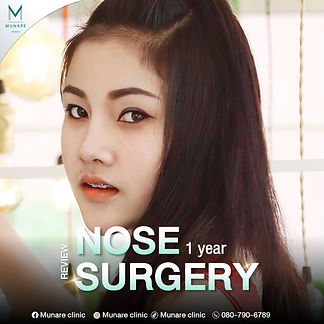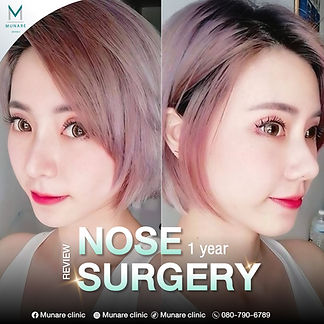
Rhinoplasty
Rhinoplasty is often the first type of cosmetic surgery people choose nowadays.
There are two main approaches: Closed rhinoplasty and Open rhinoplasty.
-
Closed rhinoplasty: Enhances nasal height, creating a more defined and attractive nose shape.
-
Open rhinoplasty: Restructures the nasal framework—reducing nose size for those with larger noses, or adding a “teardrop” tip by grafting ear cartilage or artificial tissue.
Currently, silicone implants are the most common choice, while rib cartilage from the patient’s own body may be used in rare cases where silicone is not tolerated.
Other nasal enhancement techniques include:
-
Alar base reduction (nostril narrowing)
-
Nostril reshaping
-
Interdomal suturing
-
Selecting the best silicone implant quality

Our Rhinoplasty Technique
Our technique is different from others—we focus on the concept “Naturally High and Beautiful”.
We begin with a detailed analysis of your nasal structure and provide personalized consultation to design the most harmonious nose shape for your face.
-
Custom-carved silicone for each case
-
Sloped bridge with defined tip for enhanced facial dimension
-
Painless—numbing cream applied before injection
-
Sterile, high-standard surgical instruments and operating room
-
Comfortable and relaxed surgery with oral sedation before the procedure
-
USA Implant Grande silicone—safe for lifelong use
-
Short surgery time, no general anesthesia required
-
Implant placed under the periosteum
Pre-Surgery Preparation
-
Inform our staff if you have any chronic illness, drug allergies, or are pregnant.
-
Let our staff know if you require a medical certificate.
-
No need to stop eating, birth control pills, or prescribed medication for chronic diseases (e.g., hypertension, diabetes).
-
Foods and drinks to avoid:
-
2 days before and on surgery day: Tea and coffee
-
At least 2 weeks before surgery: Vitamins, supplements, painkillers, weight loss pills, alcohol
-
-
Stop smoking 1 month before surgery.
-
Wash your hair thoroughly before surgery day.
-
Do not wear makeup or contact lenses on the day of surgery.
-
Wear a short-sleeved shirt or one with front buttons.
-
Remove all jewelry (necklaces, earrings) before surgery.
-
Trim nails clean for easier wound care at home.
-
Arrive 30–45 minutes before your appointment for preparation and numbing cream application.
Post-Surgery Care & Recovery
-
For the first 3 days: Apply cold compress on cheeks and forehead to reduce pain and swelling.
-
From day 4 onward: Switch to warm compress.
-
Clean the inside of nostrils daily (morning & evening) until stitches dissolve.
-
On day 7: Remove plaster and soft splint. If plaster is sticky, apply saline to loosen it.
-
Sleep with head elevated—use a neck pillow, avoid side or face-down sleeping to prevent pressure on the nose.
-
Follow prescribed medication strictly.
-
Avoid washing your face for 7 days; use wet wipes or gentle cleansing products instead.
-
Swelling and bruising are normal in the first 1–2 weeks and will gradually subside.
-
When sneezing or coughing, avoid tightly pinching your nose to prevent bleeding.
-
Avoid wearing glasses for 2 months.
-
Refrain from alcohol and smoking for about 2–3 months.
-
Avoid heavy exercise for 1 month.
-
Contact us via LINE or phone if you have concerns or unusual symptoms.
Ideal Candidates
-
Individuals with low nasal bridge height
-
Those whose face lacks definition due to a low bridge
-
Those with a nasal tip lower than the bridge




